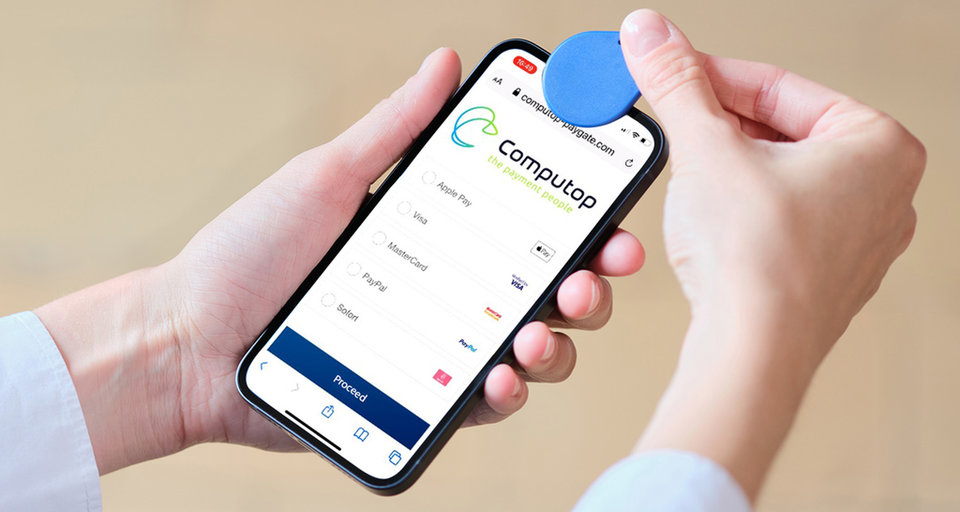Security
Computop Close-by: fast and flexible NFC payments, without an app
For a long time, contactless payment with a smartphone was only possible with methods such as Apple Pay or Google Pay. Computop Close-by will change all that

A
pple has still not opened its NFC interface for other payment solutions. But with launch of the new Computop Close-by service, the use of NFC signals for payment is about to become much easier for retailers and service providers.
The ability to shift the payment process to the smartphone - without an app and without registration – is a key selling point of Computop’s Close-by offering.
The launch of Computop Close-by is set against a backdrop of change in how payments are being made, particularly in retail. Paying online without POS terminals, even at vending machines or in shops, is very easy thanks to passive NFC tags or the use of an active NFC transmitter to call up a ready-configured payment page on the smartphone.
Customers select their favourite payment method and pay directly, often using fast wallet solutions like PayPal or the new Click to Pay. #
Apple Pay and Google Pay have also proved convenient to use and at the same time support secure biometric authentication. All of which makes a POS terminal in retail almost redundant. Payments can instead be made directly with digital price tags on the shelf, via the product label or in a promotional area.
As well as retail and multiple other scenarios, Computop Close-by will also offer flexibility for consumers paying at EV charging stations. Currently it is not possible in the UK to park up and charge using a credit or debit card on all charging networks as many require drivers to download an app, go to the company’s website or use an RFID card. However, Computop Close-brings e-commerce-type payment methods such as PayPal, Direct Debit or Alipay into play. With the appropriate configuration in the merchant system, active NFC transmitters can integrate fixed or variable payment amounts securely encrypted in the link.
Ralf Gladis, founder and co-owner of Computop, explains: "Computop Close-by is, like many innovations, an intelligent combination of existing technologies. The NFC process combined with an efficient e-commerce checkout makes a variety of payment situations easier and more flexible. That is why we have applied for international patent protection for this product."
Solicit donations digitally, from any location
Computop Close-by is particularly suitable for soliciting donations. With a simple and inexpensive NFC tag, for example a sticker or a key fob, the payment page is called up on the smartphone. An amount can also be transmitted directly, so that only confirmation by the donor on the smartphone is necessary.
Since passive NFC tags do not require their own power supply, digital donation is possible everywhere where network coverage is available.
Compared to calling up a QR code, the NFC method is simpler and more secure. Modern smartphones respond directly to the NFC signal without having to activate the device and camera app. In addition, QR codes are easy to forge, while NFC coding is permanent and cannot be overwritten. Overlapping by a fraudulent signal is also ruled out, as smartphones do not react to overlapping radio signals.
Computop IS0 27001: setting new security standards
Says Gladis: “Large banks have been working with us for the past 20 years. The protection of sensitive data is more important than ever before and will play a key role in the course of digitalisation for banks and merchants. For this reason, we elected to be certified according to ISO-27001. This makes us one of the few payment service providers in Europe that has proven its security with the ISO 27001 certificate as well as being a PCI-certified network operator-it does give us a competitive edge.
ISO 27001 certificate is an internationally recognised information security management system. Based on the 114 standards of the certificate, a number of measures have been implemented that additionally strengthen data security in Computop.
These range from management to employees to data centres and external service providers. In addition, regular audits ensure that the system is constantly improved ensuring that the requirements of ISO 27001 are permanently met.
Click to Pay: the future of credit cards
Looking ahead, Gladis is optimistic that click to pay represents the future of credit cards. He is just ever so slightly frustrated that some other key players in the ecosystem need to speed up.
“In Germany, for example, I wish that banks would register users automatically. Why should I have to register myself, if my bank could do it for me? Some banks are currently too slow. Banks need to be given a bit of a push.”
Ralf Gladis, Computop speaks with EPI editor
Ralf Gladis, Computop speaks with EPI editor
As for SCA, he suggests that the UK might actually have been wise to permit its latest deadline extension.
“I am optimistic that the UK can learn lessons from the experience in Europe. In mainland Europe, the banks have not been so focussed as they should be on the user experience.”
Better protected with 3-D Secure 2 and token technology
With Click to Pay, the 3-D Secure 2 process protects all credit card payments. Scheme tokens provide additional security. The wallet on the customer's device only stores tokens, which are card pseudonyms of the original card data. Only the owner of the physical card and the card-issuing bank know the associated card data.
Both technologies significantly improve security when shopping. They also guarantee higher authorization rates by the issuing banks.
Specifically and crucially, exemptions are not yet in place.
“We analysed 100 million transactions in Europe over a three month period. We found that the conversion rate under 3D secure 2 was about 2-4% less than under 3D Secure1-that is not how technology should work,” concludes Gladis.
